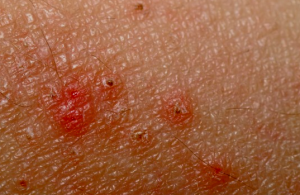Strawberries are small bulb-shaped fruits that contain varied nutrients like potassium, iron, vitamin C, and folic acid, etc. Its seeds are present on its skin. It has a distinctive essence and flavor and is low in calories. Despite all the benefits, some people may have strawberry allergy.
Symptoms of strawberry allergy
Common signs and symptoms of strawberry allergy are listed below:
- Skin rashes: Strawberry allergy is marked by development of an itchy, reddened, swollen and puffy skin rashes, with the most common being hives, contact dermatitis, and pruritus.
- Hives are red patches on skin or welts which occur in groups. They are very itchy. They form and clear out on its own within some minutes. Contact eczema or contact dermatitis occurs as part of skin reaction towards direct exposure to an allergen. It causes itchy blisters which may ooze, scab, and become infected. Swollen, inflamed, and itchy skin is referred to as pruritus.
- Excessive scratching of strawberry allergy skin rash can damage the skin and cause open wounds which are then susceptible to secondary infections by bacteria, etc.
- Digestive problems: Patients may suffer from gastrointestinal problems such as an upset stomach, vomiting, nausea, diarrhea, bloating, and abdominal pain, cramps, and swelling.
- Respiratory problems: It is a severe reaction of strawberry allergy.
- In mild cases, patients may suffer from nasal congestion or a runny nose, sinus swelling or pressure, postnasal drip, and sneezing.
- In severe cases, patients may suffer from breathing problems, increased coughing, wheezing, breathlessness, chest tightness, chest pain, sudden blood pressure drop, rapid heartbeat, fainting, dizziness, unconsciousness, and shock.
- Other symptoms: Strawberry allergy can also cause tingling, swelling, and/or numbness in the throat, mouth, or tongue; itchy and watery eyes; burning lips; and/or swelling of the fingers, hands, or face.
- Anaphylaxis: It is a life-threatening reaction of strawberry allergy marked by severe respiratory problems that require emergency medical care. It is quite rare.
Causes
Strawberry allergy occurs when the immune system mistakenly identifies a specific strawberry protein as being harmful for the body. The allergic reaction does not occur when a person consumes it for the first time. Instead, the immune system creates IgE antibodies for it during this time. When strawberries are eaten for the second time, then the antibodies get activated, enter the blood, and trigger histamine production by the body cells. This eventually results in the varied symptoms associated with strawberry allergy.
Researchers have found that the protein responsible for causing the allergic reaction is the same which imparts the red color to the fruit. It has a molecular structure which is slight similar to that of birch pollen.
Treatment of strawberry allergy
- Avoiding strawberry and all products containing strawberry as an ingredient is the best way to prevent strawberry allergy. So, check the label for strawberry content before buying products.
- Besides foods, strawberries are also present in cosmetics, shampoos, skin care products, conditioners, laundry detergents, and air fresheners.
- Parents of children with strawberry allergy especially need to look out for strawberry in ice creams, mixed fruit juices, pastries, milkshakes, pies, and jams. Processed strawberry cannot modify the culprit protein. So avoid it.
- Inflamed skin can be alleviated with OTC hydrocortisone creams.
- Antihistamines and prescription corticosteroid lotions can help find relief from itchiness and swelling.
Intake of white strawberries as well as artificial strawberry flavor does not cause the allergic reactions. So patients can eat them.
Strawberry allergy rash pictures
Here are images of rash on the body



Накрутка Twitch Зрителей
Где Вы ищите свежие новости?
Лично я читаю и доверяю газете https://www.ukr.net/.
Это единственный источник свежих и независимых новостей.
Рекомендую и Вам